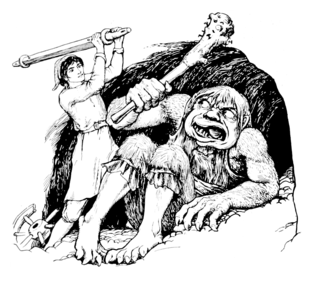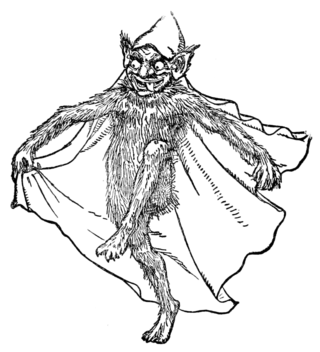
A fairy tale is a short story that belongs to the folklore genre. Such stories typically feature magic, enchantments, and mythical or fanciful beings. In most cultures, there is no clear line separating myth from folk or fairy tale; all these together form the literature of preliterate societies. Fairy tales may be distinguished from other folk narratives such as legends and explicit moral tales, including beast fables. Prevalent elements include dragons, dwarfs, elves, fairies, pixies, giants, gnomes, goblins, griffins, merfolk, monsters, talking animals, trolls, unicorns, witches, wizards, magic, and enchantments.

A fairy is a type of mythical being or legendary creature, generally described as anthropomorphic, found in the folklore of multiple European cultures, a form of spirit, often with metaphysical, supernatural, or preternatural qualities.

A boggart is a supernatural being from English folklore. The dialectologist Elizabeth Wright described the boggart as 'a generic name for an apparition'; folklorist Simon Young defines it as 'any ambivalent or evil solitary supernatural spirit'. Halifax folklorist Kai Roberts states that boggart ‘might have been used to refer to anything from a hilltop hobgoblin to a household faerie, from a headless apparition to a proto-typical poltergeist’. As these wide definitions suggest boggarts are to be found both within and out of doors, as a household spirit or a malevolent genius loci inhabiting fields or other topographical features.The 1867 book Lancashire Folklore by Harland and Wilkinson, makes a distinction between "House boggarts" and other types. Typical descriptions show boggarts to be malevolent. It is said that the boggart crawls into people's beds at night and puts a clammy hand on their faces. Sometimes he strips the bedsheets off them. The household boggart may follow a family wherever they flee. One Lancashire source reports the belief that a boggart should never be named: if the boggart was given a name, it could neither be reasoned with nor persuaded, but would become uncontrollable and destructive.

A kelpie, or water kelpie, is a shape-shifting spirit inhabiting lochs in Irish and Scottish folklore. It is usually described as a grey or white horse-like creature, able to adopt human form. Some accounts state that the kelpie retains its hooves when appearing as a human, leading to its association with the Christian idea of Satan as alluded to by Robert Burns in his 1786 poem "Address to the Devil".

The púca, pucapwca, pooka, phouka, puck is a creature of Celtic, English, and Channel Islands folklore. Considered to be bringers both of good and bad fortune, they could help or hinder rural and marine communities. Púcaí can have dark or white fur or hair. The creatures were said to be shape-changers that could take the appearance of horses, goats, cats, dogs, and hares. They may also take a human form, which includes various animal features, such as ears or a tail.

An imp is a European mythological being similar to a fairy or demon, frequently described in folklore and superstition. The word may perhaps derive from the term ympe, used to denote a young grafted tree.
Tiddy Mun was a legendary bog spirit in England, who was believed to have the ability to control the waters and mists of The Fens of South Lincolnshire, The Carrs of North Lincolnshire and fens of the Isle of Ely.
The Buried Moon or The Dead Moon is a fairy tale included by Joseph Jacobs in More English Fairy Tales. It has few variants, appearing more mythological than is common for fairy tales. It was collected by Marie Clothilde Balfour from the North Lincolnshire Carrs in the Ancholme Valley; its unusual characteristics made many people doubt its origins as a fairy tale. However, when Mrs. Balfour published her notes, they were generally found reliable. The story may evidence a form of moon worship. It is catalogued as ATU 1336.

Glashtyn is a legendary creature from Manx folklore.

The black dog is a supernatural, spectral, or demonic hellhound originating from English folklore that has also been seen throughout Europe and the Americas. It is usually unnaturally large with glowing red or yellow eyes, is often connected with the Devil, and is sometimes an omen of death. It is sometimes associated with electrical storms, and also with crossroads, barrows, places of execution and ancient pathways.

Tom Hickathrift is a legendary figure of East Anglian English folklore — a character similar to Jack the Giant Killer. He famously battled a giant, and is sometimes said to be a giant himself, though normally he is just represented as possessing giant-like strength.

In folklore and fantasy, an enchanted forest is a forest under, or containing, enchantments. Such forests are described in the oldest folklore from regions where forests are common, and occur throughout the centuries to modern works of fantasy. They represent places unknown to the characters, and situations of liminality and transformation. The forest can feature as a place of threatening danger, or one of refuge, or a chance at adventure.

Folklore of the Low Countries, often just referred to as Dutch folklore, includes the epics, legends, fairy tales and oral traditions of the people of Belgium, Netherlands and Luxembourg. Traditionally this folklore is written or spoken in Dutch or in one of the regional languages of these countries.
"Thumbling," published in German as "Daumesdick" is a German fairy tale collected by the Brothers Grimm in Grimm's Fairy Tales in 1819. The Grimms included another, similar story, "Thumbling's Travels." Both stories are related to the English Tom Thumb and often share its title when translated into English.

The moss people or moss folk, also referred to as the wood people or wood folk or forest folk, are a class of fairy folk, variously compared to dwarfs, elves, or spirits, described in German folklore as having an intimate connection to trees and the forest. In German, the words Schrat and Waldschrat are also used for a moss person. The diminutive Schrätlein also serves as synonym for a nightmare creature.
Mythic humanoids are legendary, folkloric, or mythological creatures that are part human, or that resemble humans through appearance or character. Each culture has different mythical creatures that come from many different origins, and many of these creatures are humanoids. They are often able to talk and in many stories they guide the hero on their journey.

A brownie or broonie (Scots), also known as a brùnaidh or gruagach, is a household spirit or hobgoblin from Scottish folklore that is said to come out at night while the owners of the house are asleep and perform various chores and farming tasks. The human owners of the house must leave a bowl of milk or cream or some other offering for the brownie, usually by the hearth. Brownies are described as easily offended and will leave their homes forever if they feel they have been insulted or in any way taken advantage of. Brownies are characteristically mischievous and are often said to punish or pull pranks on lazy servants. If angered, they are sometimes said to turn malicious, like boggarts.

A goblin is a small, grotesque, monstrous creature that appears in the folklore of multiple European cultures. First attested in stories from the Middle Ages, they are ascribed conflicting abilities, temperaments, and appearances depending on the story and country of origin, ranging from mischievous household spirits to malicious, bestial thieves. They often have magical abilities similar to a fairy or demon, such as the ability to shapeshift.
In the folklore on the Anglo-Scottish border, the Brown Man of the Muirs is a dwarf who serves as a guardian spirit of wild animals. Also is a Folklore story, called "Brown Man of the Moor" in the Richardson's Table Book in the 19 century according to Publications of the Folklore Society of North England, where appear the creatures: boggleboes, bogies, redmen, portunes, grants, hobbits, hobgoblins and brown men.














